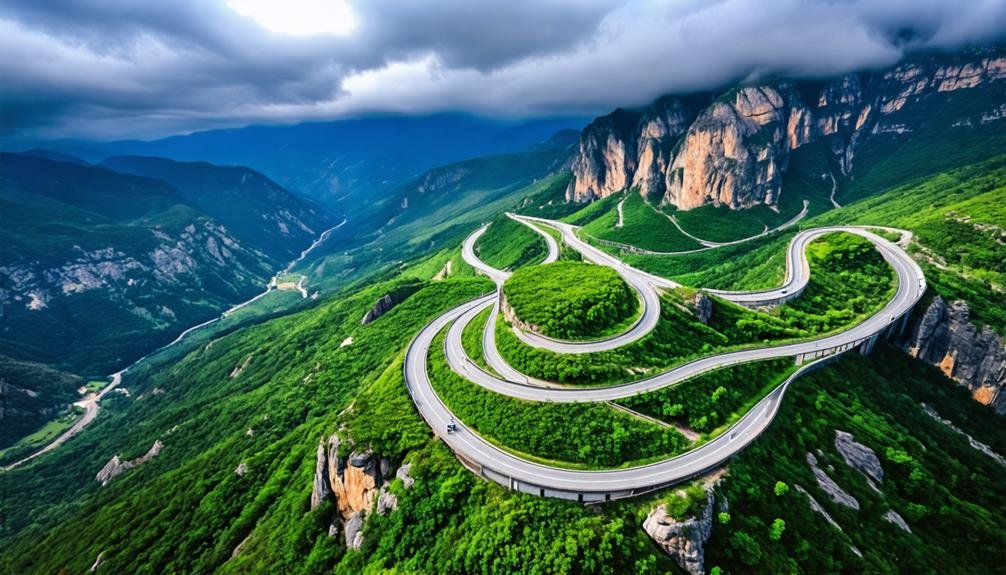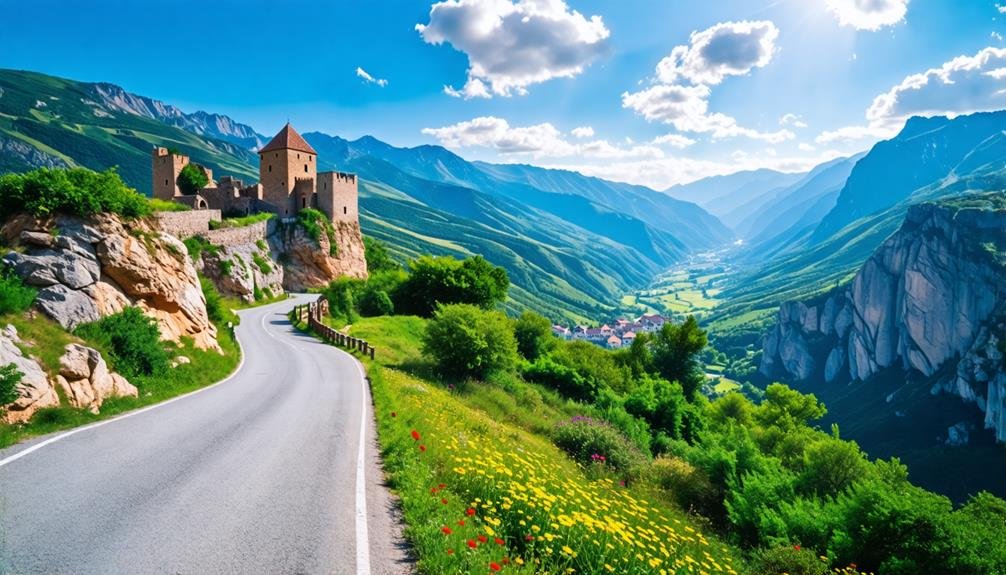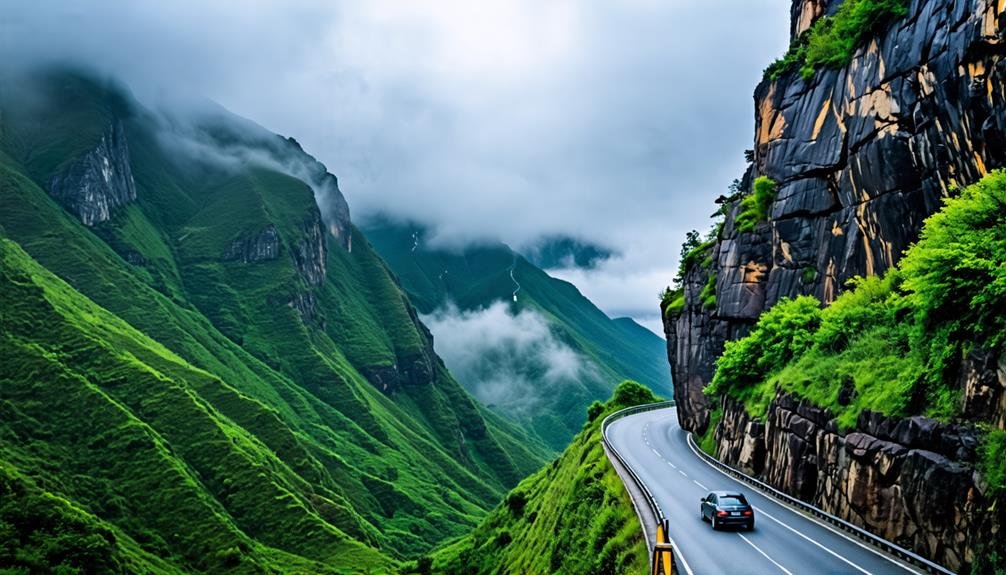The Bayburt Highway, stretching 105 kilometers through northeastern Turkey, is often considered one of the world's most dangerous roads due to its hazardous driving conditions. Characterized by 38 sharp curves and steep drop-offs, notably at the perilous Derebaşı Turns, the road demands exceptional driving skills and awareness. Unpredictable weather, including snowfall and mudslides, further complicates travel. Originally constructed during World War I, this route serves as a crucial connection between inland regions and the Black Sea coast. As travelers navigate its treacherous sections, they will encounter stunning landscapes and historical sites that enrich the expedition, revealing more about this adventurous roadway.
Overview of Bayburt Highway
The Bayburt Of Yolu, a 105-kilometer highway in northeastern Turkey, links the town of Bayburt with the coastal area of Of along the Black Sea. Originating during World War I, this roadway has transformed into one of the most infamous hazardous routes, attracting adventurous travelers and extreme driving aficionados. The Bayburt Highway is more than just a means of transport; it embodies the spirit of adventure and the quest for freedom that many seek in Turkish exploration.
Navigating the Bayburt Of Yolu presents distinct challenges. The central stretch consists mainly of loose gravel and mud, especially treacherous during adverse weather conditions. Regular snowfall results in road closures from October until summer, limiting accessibility. The design includes 38 hairpin bends, frequently devoid of guardrails, which intensifies the dangers for motorists. Additionally, this highway is shared with large trucks and various vehicles, complicating driving experiences.
Despite these obstacles, the Bayburt Of Yolu remains an alluring route for those who relish the excitement of traversing one of the world's most perilous roads, making it an unforgettable destination for adventure seekers in Turkey.
Reasons for Its Danger
The Bayburt Highway is notorious for its hazardous conditions, primarily due to its numerous hairpin turns and unpredictable weather. With 38 sharp curves lacking guardrails, the road demands exceptional driving skills to navigate safely. Moreover, poor weather can exacerbate the risks, as snowfall and mud can render sections of the road treacherous, making it crucial for motorists to exercise extreme caution.
Hairpin Turns Hazard
Navigating the hairpin turns on the Bayburt Of Yolu poses substantial challenges due to steep inclines and the absence of protective barriers. This roadway features 38 hairpin bends, recognized as some of the most perilous segments. Drivers need exceptional skill and concentration to handle the sharp angles that can easily lead to loss of vehicle control. Without guardrails, even a minor error can result in dire outcomes, including falling off steep cliffs that can drop nearly 1,000 feet.
Moreover, the road's narrowness intensifies the situation, as vehicles must contend with limited space alongside other road users, such as freight trucks. The combination of steep slopes and the potential for soil erosion and rockfall introduces further hazards. Motorists must stay alert and maintain command at all times, as even seasoned drivers can be surprised by the unpredictable landscape. For thrill-seekers, these hairpin turns provide an exciting adventure, yet they necessitate caution and respect to ensure safety on this challenging route.
Poor Weather Conditions
The Bayburt Of Yolu presents significant challenges due to its sharp bends and adverse weather conditions, which heighten the dangers of navigation throughout various seasons. The area endures severe winters, with substantial snowfall often resulting in road closures from October until summer. During this timeframe, the build-up of snow creates hazardous driving circumstances, leaving even seasoned drivers at risk.
Alongside snow, rainfall can trigger mudslides, especially in the central stretch, which consists mainly of loose gravel and dirt. This erosion diminishes traction and raises the risk of rockfalls, complicating safe travel further. Additionally, fog poses a considerable threat, particularly in the early morning hours, where visibility can drop to alarming levels.
Motorists traversing the Bayburt Of Yolu must also navigate abrupt weather shifts, where clear skies can swiftly change into storms. These elements collaboratively contribute to its reputation as one of the most perilous roads globally. Therefore, those seeking adventure must respect the natural environment and prepare thoroughly before embarking on this challenging journey.
The Derebaşı Turns

The Derebaşı Turns, situated in the Sognali mountains, pose a significant challenge for drivers. This section of the Bayburt Highway features 13 switchbacks with steep slopes, reaching gradients of up to 17%. Known for its dramatic drop-offs, some areas descend nearly 1,000 feet, making it particularly daunting for those unfamiliar with high-altitude driving. The complex layout of the turns requires both skill and confidence from motorists, as any error could lead to severe consequences.
For experienced adventurers, navigating the Derebaşı Turns transforms into an exhilarating test of driving ability. Each turn unveils a distinct view of the rugged terrain, appealing to those who seek the thrill of the open road. However, it's crucial to emphasize that this route is not advisable for beginners or individuals with a fear of heights, as the absence of guardrails and narrow pathways significantly increase the risks involved.
Historical Significance of D915
The D915 state road, featuring the challenging Derebaşı Turns, is historically significant. Russian troops built it during World War I to connect Trabzon, a coastal city, with northeastern Turkey's inland regions. This strategic thoroughfare facilitated troop and supply movement during tumultuous times, providing access to remote areas.
Over a century later, the D915 remains a vital transport link, reflecting the region's complex history. The road highlights the engineering skills of its time, despite facing challenges like weather-related wear. Its central portion, made primarily of loose gravel and mud, showcases the historical context of its construction, which depended on local labor and materials.
Beyond its military importance, the D915 has become a symbol of adventure and resilience. Today, it draws travelers seeking to experience its rugged beauty, serving as a reminder of its storied past while posing risks due to its precarious conditions.
Tourist Attractions Along the Route

The Bayburt Of Yolu is lined with numerous attractions that showcase Turkey's rich cultural tapestry and stunning landscapes. Travelers on this historic road will discover the ancient Bayburt Castle, a formidable structure that offers insights into the region's medieval history. Perched on a hill, this fortress provides breathtaking panoramic views of the surrounding fields.
The charming village of Demirözü is another highlight, featuring traditional homes and local artistry that reflect the authentic lifestyle of the area. Nature lovers will be drawn to the Soğanlı Valley, famous for its picturesque waterfalls that enchant visitors with their tranquil beauty.
For those in search of spiritual solace, the route is dotted with historical monasteries, including the notable St. John Monastery, which invites visitors to explore its serene grounds. Each site along the Bayburt Of Yolu enriches the travel experience and enhances the appreciation of Turkey's diverse cultural heritage. The blend of historical landmarks and natural wonders makes this journey a must for adventurous explorers eager to uncover the hidden treasures of northeastern Turkey.
Driving Tips for Adventurers
Traveling the rugged Bayburt Of Yolu requires thorough preparation and awareness of unique dangers. Before starting your journey, ensure your vehicle, preferably a Jeep Wrangler or Toyota 4Runner, is suitable for rough terrain. These four-wheel-drive vehicles excel on the gravel and mud that dominate the highway's central areas. Check the weather forecast, as heavy snowfall may lead to road closures from October until summer.
While on the road, maintain a consistent speed and stay alert, especially in sections with sharp curves and steep inclines. This highway is notorious for its 38 hairpin bends, demanding precise control. Be cautious of rockslides and erosion, as these natural occurrences can happen suddenly.
Also, remain vigilant for oncoming vehicles, particularly large trucks that struggle on narrow roads. When approaching the challenging Derebaşı Turns, proceed with extreme caution; the steep drop-offs require a steady hand and unwavering focus. Consider traveling with a friend for added safety and support on this exhilarating journey. Embrace the thrill of the open road while acknowledging its challenges, ensuring an unforgettable ride along this infamous highway.
The Highway's Enduring Legacy

Bayburt Of Yolu captivates adventurers and challenges skilled drivers. This winding road symbolizes peril and allure in northeastern Turkey. Built during the Great War, it stands as a testament to human resilience and the quest for freedom. Hazardous turns and unpredictable weather deter the timid but attract thrill-seekers and extreme driving enthusiasts.
The highway's historical importance, paired with its notorious reputation, makes it a unique draw in adventure travel. Each hairpin bend delivers an exhilarating ride, while scenic views showcase the stunning Turkish landscape. More than just a road, it serves as a rite of passage for those brave enough to embrace its trials.
As a vital link between coastal and inland areas, Bayburt Of Yolu connects communities. Its legacy is filled with tales of triumph, caution, and the indomitable spirit of adventurers, solidifying the highway as an enduring symbol of exploration and excitement.




